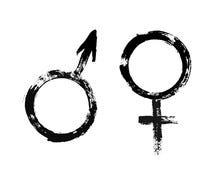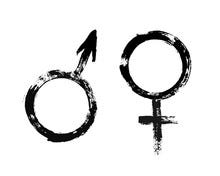After literally years of thinking, “It would be fun to ride a bike again,” I finally broke down and bought a very basic bicycle. I got it home and proudly showed it to my husband, who agreed it was a good-looking bike. He then casually asked if I was aware I’d bought a woman’s bike. Needless to say, I was not aware. But once he brought it up, I saw that the bike was indeed missing that extra bar connecting the middle of the bike. So that got us discussing how odd it was that men’s bikes have the extra bar. Wouldn’t men be more at risk of coming down on that bar in a sensitive area? Perhaps. But I looked it up and the bar is there to give additional strength to the frame when carrying men, who are generally heavier. But as it turns out, the average weight for a female in the U.S. is 170 lbs. — and I’m fifteen pounds lighter than that. So, I decided to keep the bike, fairly confident that it would not fall apart, and that no one was going to point and tease me about riding a girl’s bike.
This got me thinking about other products that are different for men and for women — but perhaps don’t need to be. Razors are different colors (and different prices, with women’s generally higher), but is there any difference in the design or sharpness of the blades? I doubt it. Men’s shirts and women’s shirts button on different sides. Most people (men and women) are right-handed and men’s shirts reflect this biological fact. Women’s shirts, on the other hand, button on the left — because in the 19th century women of a certain class had people who buttoned their shirts for them. But does this make the slightest bit of sense in the modern world?
I think we are still burdened with a lot of these needlessly gendered products, because we are only recently emerging from a time when men and women were seen as so different as to almost be separate species. Their abilities and roles in the world were perceived as entirely different. But over the last couple of centuries, it has gradually become clear that women are not only as intelligent as men, they are capable of doing most of the same things. It wasn’t until 1972 that women were allowed to compete in marathons. They don’t win them, but the top competitors can still outrun the vast majority of males (including me). Female power lifters may not be able to compete against the top men in the field — but they can out-lift me and probably you.
And then we have the issue of restrooms. I remember it was astonishing a quarter of a century ago when the TV show Ally McBeal depicted restrooms that were shared by the men and women of the law firm. This was fiction, of course, but I’ve now seen a few instances of this in real life. More commonly, I’m seeing bathrooms where the toilets themselves are segregated, but the sinks for washing up are shared. This doesn’t seem to be causing any particular problems. Honestly, I think predators (who are rarely trans or even posing as trans, by the way) might be more wary of attacking or harassing a woman in the restroom when at any moment another man, perhaps bigger than him, could come into the room.
Making the sex segregation of bathrooms less rigid would also be useful in big venues like theaters and stadiums. There are rarely lines for the men’s room and always insanely long lines for the women’s room. Wouldn’t it make sense for the rule to be that any woman who wanted to could use one of the stalls in the men’s room? These days, urinals usually have privacy partitions, and even if they don’t, the only way to see someone’s genitals would be if you were at the urinal and actively looking to see them. A woman who wanted to duck into a stall for a quick pee would not be doing anyone any harm, and no delicate sensibilities would need to be ruffled.
I can even imagine a future (seen occasionally in science-fiction movies) where men and women share locker rooms. As a gay boy, I had to get used to changing clothes in front of people I was attracted to. I somehow managed to not assault (or even approach) anyone. The idea that a woman couldn’t undress in front of men without driving them crazy with desire is simply not true. We live in a society with sexy, scantily clad people everywhere. People who are not able to rein in their sexual desires have no place in a modern society. That said, there still are far too many of these people, so I’m not suggesting that we are ready for gender-neutral locker rooms (or even bathrooms) just yet. I’m just saying that as we get better about teaching boys and men to control their emotions and sexual urges, the necessity for even these kinds of sex-segregated spaces may lessen or disappear.
Conservatives love to point out that people cannot change their sex, and that the vast majority of the population has XX or XY chromosomes. They are correct. Biological sex is real, and cannot be altered (at least we don’t yet know how). But as I’ve pointed out before, we don’t have direct perceptual access to someone’s chromosomes. What we do have access to is their gender expression, how they appear and how this accords with our perceptions of the differences between the sexes.
As the hysteria about trans people continues to mount in right-wing circles, we are seeing more cases of cisgender (non-trans) women being harassed in restrooms because someone doesn’t think they look feminine enough to be there. Sometimes cisgender men or boys are harassed in the men’s room. A father recently had to come to the defense of his long-haired son when the boy was being accused (by a stranger) of using the wrong restroom. This kind of thing is inevitable when you whip up hysteria about how other people dress or present themselves.
The fact that so many trans people are able to “pass” as the opposite sex highlights the fact that humans are not as dimorphic as we often think. Yes, our secondary sexual characteristics differ in many key ways — but most of these differences (which exist on a spectrum) are mediated by hormones, which vary widely in different individuals. At the extreme end, there is Androgen Insensitivity Syndrome (AIS), a genetic condition where the body's cells and tissues are unable to respond to male sex hormones, leading a person with XY chromosomes to have a female phenotype, or sometimes ambiguous genitalia. This is a rare condition, but even within the “normal” population, there is a lot of variation in hormone levels and responses to hormones, as well as wide genetic variations resulting in differences in height, hairiness, body fat composition and other traits we associate with one sex or the other.
So what should be the correct policy on sex segregation, given the realities of the day? The first thing to make clear is that in privately owned facilities, it should be entirely up to the owner to make these decisions. As for public facilities, I think the policy should be that the patrons get to choose which bathroom best suits them. The authorities should only become involved if someone is behaving inappropriately (if you are an Objectivist or an advocate of liberty at all, you should understand the problems with preventive law). The reality is that trans people are rarely the ones acting out in public restrooms. Almost universally, they want to stay under the radar and just do their business. It is usually some busybody who is causing the disturbance. In a just world, the government should only get involved when someone’s rights are being violated. Having a person you don’t like the looks of peeing in a stall next to you does not constitute a violation of your rights.
I think we often fail to fully grasp how transitional a time this is with regards to sex roles and gender expression. I would be surprised if the world in a hundred years looked anything like what we’re seeing now. As sex roles continue to become less rigid, we may see fewer “trans” and even “gay” people, and more people who are simply comfortable expressing all the different aspects of themselves. I think we’re starting to see this already, with many young people identifying as “fluid,” or “non-binary.” While these labels may be trendy — and certainly irritate the hell out of conservatives — it’s possible that this rejection of traditional gender roles is a good thing. Maybe it is part of a growing recognition that we share much more in our common humanity than separates us based on our sex.
I suspect time will tell. I just wish I were going to be around in 100 years to see how it all pans out!




I’m amazed that the average weight for a US female is 170#; I might have guessed 150#. A lot of what you say makes sense, Stewart, and I’m strongly opposed to preventive law. I agree that private businesses have the right to implement whatever policies they choose, including gender neutral facilities. However, there are a LOT of boomers, for whom the adjustment is likely to be hard to make, regardless of their politics. (I don’t mean myself, I think I’d get used to it pretty quickly.) Maybe I’m underestimating my fellow boomers, but it would be a pretty big adjustment, after the cultural norms we grew up with. Would businesses lose customers? My biggest fear is that politicians would feel the need/obligation to get involved when it’s none of their damn business. Political involvement would only make the transition far more difficult, or hinder it altogether.
I think the reason girl’s bikes didn’t have the horizontal bar was so that they could wear skirts/dresses!